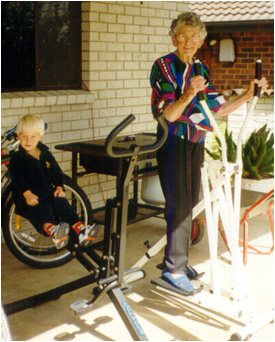We live longer today than at any other time in the past.1 Amongst westerners, average life expectancy has increased 30 years over the last century. Cleaner water, better sanitation, refrigeration, economic development and healthier diets have all contributed to many of these years. Five of the years are said to have increased due to improvements in medical care.2
“Today, one in every 10 persons is 60 years or older but by 2050, one out of every 5 people will be greater than 60.” – Leopold, 20023
Nervous system interference, often associated with spinal related disorders, has been linked to chromosomal damage, loss of muscle strength and loss of memory.4-6
“When I grow up I want to be a little boy.” – Joseph Heller

The findings of two recent studies suggest that older people who receive ongoing chiropractic care are:7,8
- More likely to exercise vigorously
- Less likely to be hospitalised
- Less likely to need a nursing home
- More likely to report a better health status
- Less likely to need to use prescription drugs
- More likely to be active in the community
Tai Chi

Elderly who are susceptible to falls or who have had a fall are often institutionalised. A single non-injury fall tripled the likelihood of admission to a nursing home, and a fall with injury resulted in a 10 fold increased admission.9 There is some good news though. A study has found that elderly patients taking Tai Chi improve their balance and reduce their number of falls. Tai Chi uses slow graceful movements to improve both balance and body awareness. The study found a 15 week programme reduced the rate of falls by 47.5%!10
Apart from taking up Tai Chi, your chiropractor can give you simple and effective exercises to improve your balance and bodies awareness in space (proprioception). At Shirley Rd Chiropractic we utilise the Pondera Balance System which allows us to determine someone’s “balance age” and falls risk. This is an assessment that gives very useful information and can help in a strategy to improve any balance issues that have arisen from visual loss, vestibular (inner ear) loss or proprioceptive (sensory) loss.
One-leg stance time has been shown to be a good indicator of falling risk in the elderly.11,12 A one-leg stance time of less than 30 seconds is associated with an increased risk of having fallen, whereas greater than 30 seconds is associated with a low risk of falling.12
References
- Crews, D.E. (1993) Biological anthropology and human ageing: some current directions in ageing research. Annual reviews of anthropology. 22: 395-423.
- Bunker, J.P., Frazier, H.S., Mosteller, F. (1994) Measuring effects of medical care. The Milbank Quarterly. 72: 225-258.
- Leopold, E. (2002) World getting older and few nations can cope. United Nations, Mar 28, 2002. Second World Assembly on Ageing in Madrid from Apr 8-12.
- Jiang, H., Moreau, M., Raso, J., et al. (1997) Identification of the location, extent and pathway of sensory neurologic feedback after mechanical stimulation of a lateral spinal ligament in chickens. Spine 22: 17-25.
- Ohtori, S., Takahashi, K., Chilba, T., et al. (2000) Fos expression in the rat brain and spinal cord evoked by noxious stimulation to deep low back muscle and skin. Spine 25: 2425-2430.
- Luoto, S., Taimela, S., Hurri, H., et al. (1999) Mechanisms explaining the association between low back trouble and deficits in information processing – a controlled study with follow-up. Spine 24: 255-261.
- Rupert, R.L. et al. (2000) Maintenance Care: Health promotion services administered to U.S. chiropractic patients aged 65 and older: Part 2. J. Manipul. Physiol. Ther. 23: 34-41.
- Coulter, I.D., Hurwitz, E.L., et al. (1996) Chiropractic patients in a comprehensive home based geriatric assessment, follow up and health promotion program. Topics in Clinical Chiropractic. 3: 46-49.
- Wiesel (1998) Backletter 13: 6-7.
- Wolf (1996) J. Am. Geriatr. Soc. 44: 489-497.
- Vellas, et al., 1997
- Hurvitz, et al. (2000) Unipedal stance testing as an indicator of fall risk among older patients. Arch. Phys. Med. Rahab. 81: 587-591.
